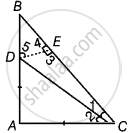Advertisements
Advertisements
प्रश्न
ABC is a right triangle such that AB = AC and bisector of angle C intersects the side AB at D. Prove that AC + AD = BC.
उत्तर
Given: In right angled ΔABC, AB = AC and CD is the bisector of ∠C.
Construction: Draw DE ⊥ BC.
To prove: AC + AD = BC
Proof: In right angled ΔABC, AB = AC and BC is a hypotensue ...[Given]
∴ ∠A = 90°
In ΔDAC and ΔDEC, ∠A = ∠3 = 90°

∠1 = ∠2 ...[Given, CD is the bisector of ∠C]
DC = DC ...[Common sides]
∴ ΔDAC ≅ ΔDEC ...[By AAS congruence rule]
⇒ DA = DE [By CPCT] ...(i)
And AC = EC ...(ii)
In ΔABC, AB = AC
∠C = ∠B [Angles opposite to equal sides are equal] ...(iii)
Again, in ΔABC, ∠A + ∠B + ∠C = 180° ...[By angles sum property of a triangle]
⇒ 90° + ∠B + ∠B = 180° ...[From equation (iii)]
⇒ 2∠B = 180° – 90°
⇒ 2∠B = 90°
⇒ ∠B = 45°
In ΔBED, ∠5 = 180° – (∠B + ∠4) ...[By angle sum property of a triangle]
= 180° – (45° + 90°)
= 180° – 135°
= 45°
∴ ∠B = ∠5
⇒ DE = BE [∵ Sides opposite to equal angles are equal] ...(iv)
From equations (i) and (iv),
DA = DE = BE ...(v)
∵ BC = CE + EB
= CA + DA ...[From equations (ii) and (v)]
∴ AD + AC = BC
Hence proved.
APPEARS IN
संबंधित प्रश्न
ABC is a right angled triangle in which ∠A = 90° and AB = AC. Find ∠B and ∠C.
AD is an altitude of an isosceles triangles ABC in which AB = AC. Show that
- AD bisects BC
- AD bisects ∠A
BE and CF are two equal altitudes of a triangle ABC. Using RHS congruence rule, prove that the triangle ABC is isosceles.
In two right triangles one side an acute angle of one are equal to the corresponding side and angle of the other. Prove that the triangles are congruent.
Prove that in a quadrilateral the sum of all the sides is greater than the sum of its diagonals.
ABC is an isosceles triangle in which AC = BC. AD and BE are respectively two altitudes to sides BC and AC. Prove that AE = BD.
In a right triangle, prove that the line-segment joining the mid-point of the hypotenuse to the opposite vertex is half the hypotenuse.
Two lines l and m intersect at the point O and P is a point on a line n passing through the point O such that P is equidistant from l and m. Prove that n is the bisector of the angle formed by l and m.
Line segment joining the mid-points M and N of parallel sides AB and DC, respectively of a trapezium ABCD is perpendicular to both the sides AB and DC. Prove that AD = BC.
ABCD is quadrilateral such that AB = AD and CB = CD. Prove that AC is the perpendicular bisector of BD.
